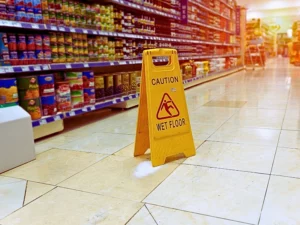If the store was negligent, you can sue Home Depot for slip and fall injuries. When you go to a Home Depot store, a simple errand to buy some things can turn into a lasting, costly ordeal if you suffer an injury from some hazard while shopping. Whether it be liquids on a floor that an employee has not cleaned up, hazards left in the aisles, or poor lighting, you should not have to be in danger from such conditions while shopping.
When you enter a store in Las Vegas, Nevada, it owes you a reasonable expectation of safety, to ensure that you are not in danger by entering the premises. If the store fails to take reasonable measures to keep its premises safe, you may be able to hold the store liable for any injuries that you suffer on the premises.
When Can You Sue Home Depot?
You can sue Home Depot if the store was negligent and, as a result, you suffered harm. Any customer who enters a store is considered an invitee. Under state law, Las Vegas stores have a duty of care toward all of their customers. Should the store breach this duty, and you suffer injuries, you may have a case to recover damages for your accident-associated losses through a premises liability lawsuit.
To be successful in a premises liability case against Home Depot, you will need to prove four essential elements:
A Dangerous Condition Existed on the Store Premises
Your case will have to establish that a dangerous condition existed in the store or on the premises. Unfortunately, with the size of the stores, at an average of 105,000 square feet of floor space per store, as well as more than 2,300 stores in North America, there are likely to be large amounts of floor space that go untended. This volume of floor space makes it inevitable that at some point there will be dangerous conditions in some of their stores. If you or a loved one has been the victim of Home Depot accidents, you may be able to file a premises liability lawsuit.
Possible Hazards That Can Cause a Slip and Fall Accident
Home Depot has many potential hazards that can lead to accidents and injuries in its stores. For example, there may be recently mopped or waxed floors, spilled liquids, or sawdust, creating slippery floors on which a customer might slip and fall. If lighting is dim, broken, or inadequate, there may be little to no visibility, which is a hazard, as customers cannot see objects or items on the floor, to avoid tripping and falling.
Additionally, hazards in the aisles can include hoses, merchandise on the floor, cracks, bumps on the floor, or construction or carpentry items left on the floor or jutting out from a shelf. Unclear and poorly maintained walkways and aisles create tripping risks, which can lead to a fall accident and injuries.
Home Depot was Negligent
It is not enough, however, for the hazard to exist. Rather, you will need to demonstrate that the store was negligent. To prove Home Deport negligent, you mush establish that the store created, knew about, or reasonably should have known about the hazard, and did not take appropriate measures to remedy the condition or warn shoppers.
The following factors will be considered when deciding if the store acted reasonably:
- Whether the store has been conducting inspections regularly
- The time between inspections
- Whether employees should have noticed the danger in the course of their normal duties
- The time it took for the danger to be discovered
- Whether warning signs were placed near the danger
- The time it took for Home Depot to remove the danger
To escape liability, Home Depot may argue that it could not have reasonably remedied the dangerous condition. For example, if are walking behind another customer, who drops some merchandise that you trip over, it is not reasonable to expect the store to have been able to prevent your accident. On the other hand, if a customer spills liquids on a floor, and this is left for most of the day, during which time you slip and fall in it, Home Depot will likely be considered negligent, and you can hold it liable.
You Were Injured by the Dangerous Condition
After establishing a dangerous condition existed and the store negligently failed to remedy it, your case will need to show that you suffered injury as a result of the condition and negligence. The dangerous condition and store’s negligence must have directly caused your slip and fall accident, and the resulting injuries, for you to successfully sue Home Depot.
To this end, it is critical to seek medical assistance as soon as possible. Your medical records can provide valuable evidence. Further, if you do not seek medical assistance timeously, Home Depot may make the case that your injuries were due to some other cause than the accident.
You Suffered Losses Due to Your Injuries
In a premises liability case, you claim compensation for all damages that you have suffered because of your injuries. Your injury claim is for damages and losses that you incurred as a direct result of your accident. Therefore, you can only seek to recover compensation if you have incurred losses, such as medical bills, wages, or the ability to earn money. If you did not suffer any such losses, you generally cannot recover compensation through a premises liability lawsuit.
How the Size of Your Settlement is Calculated
You may be wondering – what is the average payout for a personal injury claim? The answer is that the amount depends on the circumstances of your individual case. Nevertheless, it helps to know how your settlement is calculated to get an idea of what your case may be worth.
There are two types of damages that you can claim – economic and non-economic damages.
Economic Damages
Economic damages are sometimes referred to as tangible, or monetary damages. They have a dollar value that can be calculated. Economic damages are based on what the accident has cost you so far, and what it is likely to cost you in the future.
Economic damages include medical expenses, for both past and future medical bills. They also include expenses related to long-term care if you have suffered permanent injuries. You can claim damages for rehab therapy, if your injuries require you to undergo rehabilitation, which can last for months or years. Medications may be needed in recovering from your injury, and possibly for life. These are expenses for which you can claim damages.
To get a higher amount of damages, you need to prove exactly how much money you have spent on recovering from your accident. You can provide detailed medical documentation, including bills and receipts. You might also provide expert testimony from a doctor, providing details on the extent of your injuries.
Following a slip and fall accident at a Home Depot store, you may need to miss work while you are recovering. In such cases, you can also claim lost wages. If your injuries affect your ability to work going forward, you may lose future wages. You can claim this reduced earnings capacity.
To calculate your economic damages, your attorney will review and add up the costs shown on invoices, receipts, and other financial statements. Additionally, lawyers often work with financial and professional experts to extrapolate and determine the value of projected future costs.
Non-economic Damages
Non-economic damages are physical pain and suffering, for the discomfort that your injuries cause you. You can claim emotional damages for mental anguish and emotional trauma that you suffer as a result of your accident, including fear, anxiety, depression, or insomnia. If you have lost a loved one as a result of a Home Depot accident, you can claim loss of consortium. You may claim loss of self-esteem if the accident has left you with scarring, disfigurements or disability, leading you to lose self-esteem.
Calculating non-economic damages can be challenging, as they do not carry a monetary value. Often, to assign a value to such losses, legal representatives and the courts in Las Vegas, Nevada, use the multiplier method. Based on factors, such as the type, severity, and effects, of the injury, a multiplier is assigned, usually between one and five. The total economic damages are then multiplied by that number to determine the non-economic damages value.
What Can Affect the Size of a Slip-and-Fall Settlement?
Every slip and fall case is unique, and so each settlement is different. There are factors that can help in determining the size of your claim. These include:
Type of Injury
Much of the economic damages in premises liability cases result from your medical bills and lost wages. The more severe your injuries, the more medical care you may need, and more time off work to recover. Therefore, the potential value of your case may be greater for a more serious injury than it is for one that is less severe.
Permanent injuries can result in future medical bills and future reduced earnings capacity. Your attorney will take this into consideration in calculating your economic damages.
Aside from actual expenses incurred, severe injuries are more likely to result in pain, suffering, and emotional distress. Since these losses lack a tangible monetary value, your economic losses will help determine their worth for the sake of awarding you compensation in a premises liability lawsuit against Home Depot. Thus, the higher the value of your economic losses, the greater you can expect your non-economic damages award to be.
Evidence
Premises liability cases rely heavily on evidence. If you do not have sufficient evidence, you may risk losing that portion of your damages that you are unable to prove. You should be aware of what to do if you slip and fall in a store.
It is important to gather evidence as soon as you can. Some of it can disappear quickly. For example, if a hazard left on the floor caused your fall, then the store employees may move the hazard before you take a photograph. Witnesses can leave the accident scene before you collect their contact information.
You should report the accident to the store so that they can create an accident report. This report will have details of the accident and can be used as evidence, providing details of your accident, the cause of your accident, and the events surrounding it.
Evidence includes witness testimony, photographs of the accident scene, and security camera footage. Documentation also serves as important evidence in supporting your claim. This includes ambulance, paramedic, hospital, and follow-up doctor visit records. MRI’s, CT scans, X-rays, and testing records as valuable for providing an assessment of your injury.
If you are claiming non-economic damages for your pain and suffering, you may provide personal journal entries documenting the effects of the accident, medical prognosis, or therapist notes.
Your slip and fall lawyer will assist you in gathering as much evidence as possible to maximize your claim.
If You Were Partly at Fault
In Nevada, comparative negligence laws apply. If you were negligent, but your negligence contributed 50% or less to the accident, then your claim will be reduced by a percentage equal to your negligence. For example, if your negligence contributed 10% to the accident, then your damages will be reduced by 10%.
Home Depot might argue that you were partly negligent by claiming that your actions were not reasonable. Some arguments the store chain may make to try to dodge paying for your injuries include::
- The danger was obvious enough that a reasonable person would recognize and avoid it
- There were warning signs that you ignored
- You were trespassing in an off-limits area of the store
- You were intoxicated
- Your actions were otherwise inappropriate
Knowing when and how you can sue Home Depot for injuries suffered in a slip-and-fall accident while shopping may help you protect rights and interests.





